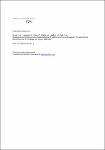Biological and Phylogenetic Characteristics of Yellow Fever Virus Lineages from West Africa
Stock, Nina K.
Laraway, Hewád
Faye, Ousmane
Diallo, Mawlouth
Niedrig, Matthias
Sall, Amadou A.
The yellow fever virus (YFV), the first proven human-pathogenic virus, although isolated in 1927, is still a major public health problem, especially in West Africa where it causes outbreaks every year. Nevertheless, little is known about its genetic diversity and evolutionary dynamics, mainly due to a limited number of genomic sequences from wild virus isolates. In this study, we analyzed the phylogenetic relationships of 24 full-length genomes from YFV strains isolated between 1973 and 2005 in a sylvatic context of West Africa, including 14 isolates that had previously not been sequenced. By this, we confirmed genetic variability within one genotype by the identification of various YF lineages circulating in West Africa. Further analyses of the biological properties of these lineages revealed differential growth behavior in human liver and insect cells, correlating with the source of isolation and suggesting host adaptation. For one lineage, repeatedly isolated in a context of vertical transmission, specific characteristics in the growth behavior and unique mutations of the viral genome were observed and deserve further investigation to gain insight into mechanisms involved in YFV emergence and maintenance in nature.
No license information
Related Items
Show related Items with similar Title, Author, Creator or Subject.
-
2010-11-24ZeitschriftenartikelDetection of yellow fever 17D genome in urine Domingo, Cristina; Yactayo, Sergio; Agbenu, Edinam; Demanou, Maurice; Schulz, Axel R.; Daskalow, Katjana; Niedrig, Matthias
-
2011-12-23ZeitschriftenartikelThe phylogeny of yellow fever virus 17D vaccines Stock, Nina K.; Boschetti, Nicola; Herzog, Christian; Appelhans, Marc S.; Niedrig, MatthiasIn recent years the safety of the yellow fever live vaccine 17D came under scrutiny. The focus was on serious adverse events after vaccinations that resemble a wild type infection with yellow fever and whose reasons are ...
-
2012-05-03ZeitschriftenartikelFirst International External Quality Assessment Study on Molecular and Serological Methods for Yellow Fever Diagnosis Domingo, Cristina; Escadafal, Camille; Rumer, Leonid; Méndez, Jairo A.; García, Paquita; Sall, Amadou A.; Teichmann, Anette; Mantke, Oliver Donoso; Niedrig, MatthiasObjective: We describe an external quality assurance (EQA) study designed to assess the efficiency and accurateness of molecular and serological methods used by expert laboratories performing YF diagnosis. Study Design: ...

